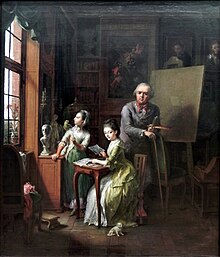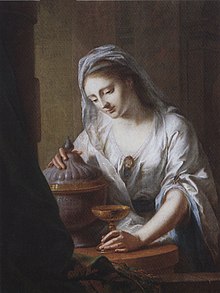Johann Heinrich Tischbein the Elder

Johann Heinrich Tischbein the Elder (born October 3, 1722 in Haina ; † August 22, 1789 in Kassel ; called the Kasseler ) was a German artist , one of the most recognized painters and one of the greatest portraitists of the 18th century .
Life
Tischbein was the most important member of the highly gifted Tischbein family of painters, which spanned four generations . He was a co-founder and teacher of painting at the Kassel Art Academy and, in keeping with the current trend, is developing into a protagonist of early classicism in Germany. He was a court painter in Kassel and mainly made portraits, but also mythological scenes, historical paintings and landscapes. His life's work includes more than 300 paintings. According to Meyer's Great Lexicon of 1984, he is considered the most excellent painter of portraits of women.
Tischbein was the son of the baker Johann Heinrich Tischbein and Susanne Margaretha Hinsing. After an apprenticeship as a painter from 1736 to 1741 in Kassel with the wallpaper painter Zimmermann and with Johann Georg von Freese (1701–1775), he was in the service of smaller royal courts. In 1743 he went to Paris , financially supported by Count Johann Philipp von Stadion , and became a pupil of Carle van Loo (1705–1765). In 1749 he traveled to Venice to see Giovanni Battista Piazzetta (1682–1754). In 1750/51 he was in Rome. In 1753 he was appointed court painter to Landgrave Wilhelm VIII of Hesse-Kassel . At the same time, work began on the Landgraves' summer palace in Wilhelmsthal , where Tischbein left a total of 66 paintings, including the “Beauty Gallery”. During the French occupation he fled from 1756 to 1762 with various stays. In 1762 he became a professor at the newly founded Academy Collegium Carolinum in Kassel. In between he spent some time at the Swabian “Musenhof” near Graf Stadion at Schloss Warthausen near Biberach an der Riss .
Through his friendship with Friedrich Gottlieb Klopstock and his brother, who was temporarily living in Hamburg, he was closely connected to the Hanseatic city. On October 31, 1756, Tischbein married the office secretary's daughter Marie Sophie Robert (d. 1759) and was married to her youngest sister Anne Marie Pernette in 1763. She died the following year in 1764. Johann Heinrich Tischbein was (like his nephew Johann Friedrich August ) a member of the Freemason lodge Zum krönten Löwen in Kassel.
In 1775, eighteen-year-old Countess Auguste Reuss zu Ebersdorf sat as a model for his most famous painting Artemisia (72 × 95 cm, oil on linen) ; she was considered one of the most beautiful women of her time.
Works (selection)

- Resurrection (1763), altar painting of the main church Sankt Michaelis (Hamburg) , burned in 1906
- Transfiguration (1765), Lutheran Church in Kassel
- Passion and Ascension cycle (1778) for the Catholic Elisabeth Church in Kassel, parts today in the Cathedral Museum in Fulda , others in today's St. Elisabeth Church (Kassel)
- Descent from the Cross and Ascension (1787), altar painting of the St. Jakobi Church (Stralsund)
- Christ on the Mount of Olives (1788), Haina Monastery
- Self-portrait with his first wife
- Portrait of the actress Evérard
- Portrait of the poet Philippine Engelhard geb. Gatterer
- The Landgrave Friedrich II.
- Allegory for the founding of the Kassel Academy
- Hercules and Omphale
- May festival at Gut Freienhagen
- The Timmermann family , canvas, 91.5 × 118 cm (image size), signature: inscribed. Middle right: JH Tischbein Pinx 1758, ( online , Old Masters Picture Gallery, Museum Landscape Hessen Kassel)
Exhibitions
- 1989/1990 Kassel: Johann Heinrich Tischbein the Elder Ä. (1772–1789)
- 2005/2006 Kassel: 3 x table legs
literature
in alphabetical order by authors / editors
- Joseph Friedrich Engelschall: Johann Heinrich Tischbein, former Princely Hessian council and court painter, portrayed as a person and an artist . Raspesche Buch- und Kunsthandlung, Nuremberg 1797 ( digitized version ).
- Anna-Charlotte Flohr: Johann Heinrich Tischbein d.Ä. (1722–1789) as a portrait painter. With a critical catalog raisonné. Tuduv-Verlagsgesellschaft, Munich 1997.
- Louis Katzenstein: Tischbein, Johann Heinrich . In: Allgemeine Deutsche Biographie (ADB). Volume 38, Duncker & Humblot, Leipzig 1894, pp. 362-371.
- Karin Schrader: Tischbein Johann Heinrich the Elder. In: New German Biography (NDB). Volume 26, Duncker & Humblot, Berlin 2016, ISBN 978-3-428-11207-5 , pp. 300-302 ( digitized version ).
- Petra Tiegel-Hertfelder: "History was his subject". Mythology and history in the work of Johann Heinrich Tischbein the Elder Ä. (1722–1789) (= manuscripts for art history in the Wernerschen Verlagsgesellschaft 49). Wernersche Verlagsgesellschaft, Worms 1996, ISBN 978-3-88462-948-2
- Hans Vollmer: Tischbein, Johann Heinrich d. Elder In: Hans Vollmer (Hrsg.): General lexicon of fine artists from antiquity to the present . Founded by Ulrich Thieme and Felix Becker . tape 33 : Theodotos vacation . EA Seemann, Leipzig 1939, p. 210-212 .
Web links
- Literature by and about Johann Heinrich Tischbein the Elder in the catalog of the German National Library
- Works by Johann Heinrich Tischbein the Elder at Zeno.org .
- Works by Johann Heinrich Tischbein in the Old Masters Picture Gallery, Kassel
- Tischbein, Johann Heinrich the Elder. Hessian biography. (As of July 23, 2020). In: Landesgeschichtliches Informationssystem Hessen (LAGIS).
Individual evidence
- ↑ Fabian Fröhlich: Where Undisturbed The Lenz Governs, Wilhelmsthal Castle near Calden. Ed. Museumslandschaft Hessen Kassel and Michael Eissenhauer. Monographic series, Volume 21. Kassel 2007, ISBN 978-3-422-02144-0 .
- ↑ This painting shows the traditional scene, which today seems macabre to us, when Artemisia II, sister and widow of King Mausolos II (377 - 353 BC) of Caria, did not put this in the tomb he erected when he died ( Mausoleum of Halicarnassus ), but rather cremated and sprinkled his ashes out of great love, but also to double the origin of both Gods, in a goblet with wine and mixed it with his own tears in deep sadness. - The kings of Caria, like the Egyptian pharaohs, were derived from gods of the sun in divine descent. Accordingly, sibling marriage was also possible.
- ↑ The portrait of Philippine Engelhard, née Gatterer, is commented on in a letter from Caroline Michaelis dated September 8, 1780: ... Tischbein painted her as a muse in a sky-blue robe on which Leyer leaned and a wreath of laurels and roses in the hair ... It is no less than beautiful, the portrait should be similar and yet pretty ... (in: Caroline. Briefe aus der Frühromantik , Volume 1, 1913, Reprint 1970, No. 18). Philippine Gatterer thanked Johann Heinrich Tischbein with a poem: "To Mr. Rath Tischbein in Cassel. When your portrait arrived in Göttingen. August 5, 1780" (in: Philippine Engelhard. Selected poems , No. 43, Würzburg 2008 )
| personal data | |
|---|---|
| SURNAME | Tischbein, Johann Heinrich, the elder |
| ALTERNATIVE NAMES | Kasseler Tischbein (nickname) |
| BRIEF DESCRIPTION | German painter in Kassel |
| DATE OF BIRTH | October 3, 1722 |
| PLACE OF BIRTH | Haina |
| DATE OF DEATH | August 22, 1789 |
| Place of death | kassel |

